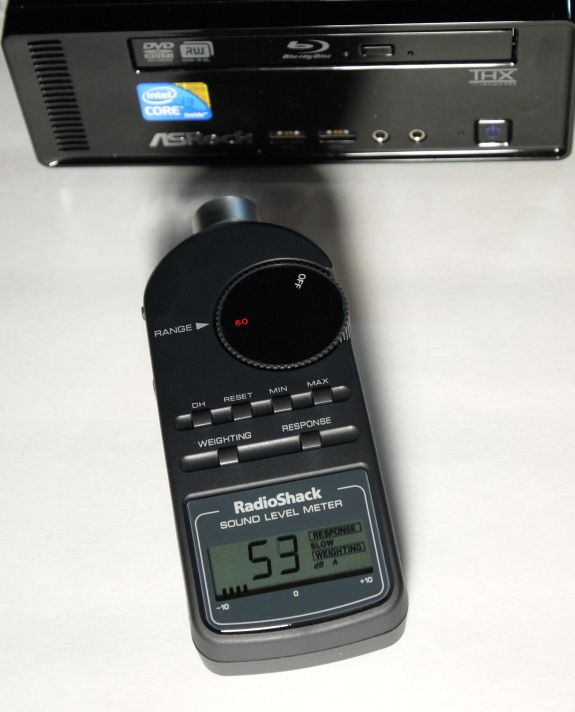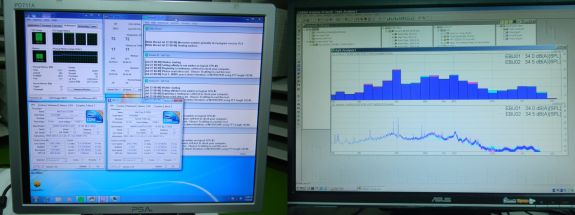ASRock Core 100HT-BD : Bringing HTPCs to the Mainstream Market [UPDATED : Noise Issue]
by Ganesh T S on July 19, 2010 9:34 PM EST- Posted in
- Home Theater
- Arrandale
- ASRock
- Media Streamer
- Core i3
- HTPC
HTPC enthusiasts are rightly concerned about the noise factor, heat and power consumption, ease of usage and many other criteria. We will tackle each of these concerns one by one in this section.
Noise
ASRock claims that the Core 100 HT-BD produces less than 25dB of noise. Under lab testing conditions, such performance is indeed possible. We decided to get hold of one of the sound meters used in setting up home theater speakers to verify whether the claims were true. Being a hobbyist sound meter, it wasn't very sensitive. The measurable sound range was only 50 - 130 dB, and there was a concern that the Core 100 would be too silent for the sound meter to pick up. As it turned out, while running Prime95 at full throttle (100% CPU utilization), the fans kicked in at full speed. The sound meter registered between 53 and 55 dB very close to the unit. [ See UPDATE below for a more practical measurement ]
The fan noise is quite audible if one sits very close to the unit. From 8 ft away, even with the unit in the open, we could barely hear it. Noise, however, is a very subjective issue. We hope the quoted number will help give readers an idea of how noisy the system gets when fully loaded. If the unit is going to be installed inside a cabinet of some sort, the noise factor becomes a non-issue.
UPDATE: One of the reasons we kept our sound detector very close to the unit was because it refused to register any measurement at the usual practical distances. While waiting to get hold of a more sensitive sound meter, we asked ASRock for lab results of sound measurement at full throttle. They were happy to oblige us with the following photographs and video from their anechoic chamber. It appears that the sound level is less than 35dB at a distance of 2 ft. even with all fans in action.
Power Consumption
In order to get an idea of the power consumption numbers, the Prime95 benchmark was let run overnight to keep the system completely loaded for an extended duration. All the four 'cores' of the CPU were pegged at 100% throughout, and we found an average power consumption of less than 48 W. At idle, the system consumed around 18 W.
These type of power consumption numbers have been enabled by ASRock's choice of going in for an Arrandale instead of a Clarkdale platform. This has resulted in a smaller form factor case design for the mini-ITX motherboard. Since there is not much heat to be dissipated, the cooling system is also appropriately small and silent.
Ease of Use
HTPC enthusiasts are concerned about how easy it is for their system to come out of standby. Existence of HDMI handshake issues upon return from standby is also a deal breaker for many. Fortunately, the Core 100 HT-BD has no issues in these two aspects. As long as the AC power adapter is connected to the system, the bundled MCE remote can be used to boot the system (even if the PC had been shut down previously). In order to shorten the boot times, ASRock supplies an Instant Boot utility. Using this, whenver the Core 100 HT-BD is shut down, it boots up once again and shuts down before the power can be safely removed. Upon power up, the boot up is instantaneous. If the user wants to put the PC in sleep mode, ASRock also supplies a Goodnight LED feature in the BIOS, which turns off the bright blue blinking LED in front. The MCE remote can also be used to bring the PC out of sleep mode.
Within Windows, the MCE remote can be made to work with a variety of applications such as XBMC, MediaPortal, MPC-HC and of course, Windows 7 Media Center. Blu Ray players such as PowerDVD and ArcSoft TMT can also be controlled with the help of the MCE remote. For the ideal I/O scenario, one probably needs to purchase a wireless keyboard / mouse combo.
It was seen in an earlier section that the Core 100 HT-BD happened to score quite well in the Anandtech Media Streamer Test Suite. The unit could playback all files using one program or the other, and people expect nothing else from a HTPC. Unfortunately, there is no single unified interface (from XBMC or MediaPortal or any other similar program) which could successfully play back all the files from within. There is definitely an ease of use issue existing here. However, this is not ASRock's fault, and will probably continue to exist on all Clarkdale / Arrandale platforms. Hopefully, projects such as XBMC's DSPlayer mature rapidly to alleviate this problem.













107 Comments
View All Comments
GreeneEyez - Tuesday, July 20, 2010 - link
Have fun bitstreaming HD audio from the Mac Mini or playing back Blu ray disks/ISOs...ganeshts - Tuesday, July 20, 2010 - link
GeorgeH,It is not possible for any home built mini-ITX box to be within the power envelop of this unit.
This uses an Arrandale processor which isn't available for purchase by the general public.
Further, as you rightly observe, the MacMini has worse specs, but looks better. Companies like ASRock provide the best bang for the buck, and in this pursuit, industrial design takes a back seat. However, things are going in the right direction, and I am sure the execution next time around will be much better from all perspectives.
softdrinkviking - Tuesday, July 20, 2010 - link
i need a tv tuner in or connected to my htpc.you say that the 100HT-BD's chipset cannot support an internal TV tuner, but that it has a smaller power envelope than a chipset which can.
in that case, you would also have to factor in the extra power used by your external TV tuner box.
you would also have to compare the cost of that box versus the cost of a tuner card.
if all things are equal (you break even), then the all-in-one solution (a beefier htpc) would be the obvious choice.
tmservo - Tuesday, July 20, 2010 - link
As others mention, since the MacMini doesn't do Bluray, and doesn't bitstream DTS-MA or DD-HD, it's not really a great HTPC. It's LPCM support also troubled, and it doesn't matter since it doesn't do Bluray. The MacMini simply isn't a very good HTPC at all. It might compete against something like an ION.. except you can get an ION with BD at 1/2 the price. Apple has to give up rejecting the "bag of hurt" that is bluray, because as long as they keep their phobia of it, they aren't in the HTPC market at allComputer Bottleneck - Tuesday, July 20, 2010 - link
It will be interesting to see your future evaluation of the AMD IGP in the HQV 2.0 benchmark.As far as this product goes I really liked reading your technical explanation of how Asrock integrated what is basically a laptop mainboard into the Mini-ITX form factor.
alaricljs - Tuesday, July 20, 2010 - link
Can I suggest in that HTPC centric features chart that under SPDIF you specify optical/copper instead of just yes/no?ganeshts - Tuesday, July 20, 2010 - link
Thanks for your suggestion, alaricjls.The SPDIF is optical, and I will update the article shortly.
dbone1026 - Tuesday, July 20, 2010 - link
Hey Ganesh,Excellent job with the review. Honestly I am surprised by some of the comments regarding an expansion slot, which to me defeats the whole purpose of ASRock making this HTPC in such a small form factor. Aside from USB tuners I know many people who use network tuners (i.e HDHomeRun) so in many cases there is no need for any sort of internal tuner. If want to strap on multiple tuners then why not just a MicroATX or ATX case as that is not the intention of this ASRock..
I honestly think the biggest challenge with the ASRock 100HT is the price. Newegg has it listed at $649 (without BR drive) and no O/S. The mini-ITX HTPC I built which was only slightly larger and was easily $100 less with better specs (using core i5). Hopefully we start seeing prices drop soon.
jabber - Tuesday, July 20, 2010 - link
I've been rolling out the dual core Atom ones for small office/home PCs. The customers love them over the old big black/grey boxes.Low power and small desk presence are a big win.
Very nicely made too.
Built about sixteen of them and not one issue so far.
erictorch - Tuesday, July 20, 2010 - link
The core i3-330m processor is available for ordering from www.superbiiz.comIf the reviewer reads this comment, can they comment on whether AHCI support is available in the BIOS menus? This is necessary to get the full performance out of a SSD. A lot of laptop bioses don't have AHCI selectable.